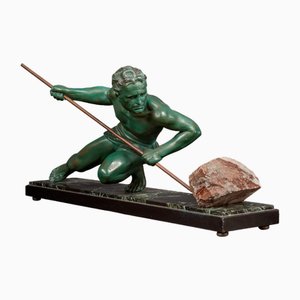Structure and Composition:
This Ethiopian processional cross is finely crafted and rich in iconographic details. It is made of metal, probably bronze or brass, and has a complex structure with several decorative elements.
Central part:
Madonna and Child: In the center of the cross, there is a representation of the Virgin Mary holding the Child Jesus. This central image is framed in a circle decorated with openwork patterns and small inlays that appear to be precious stones or pieces of colored glass.
Arm of the Cross:
Musician Angels: The side arms of the cross each feature a musician angel, playing instruments and represented in a flying position. The angels are finely detailed, with outstretched wings and carefully sculpted clothing.
At the top of the cross;
A cherub is represented, a celestial being with multiple wings and surrounded by cloud-shaped motifs.
The lower ends of the cross are decorated with motifs of birds, probably doves, a symbol of peace and the Holy Spirit, placed in openwork circles.
Base and Handle:
Engraved Base: The base of the cross, which serves as a handle, is also richly engraved with floral and geometric designs, providing a sturdy and decorative grip for processions.
History of Ethiopian processional crosses
Origins and Evolution: Ethiopian processional crosses have a long history, dating back to the introduction of Christianity to Ethiopia in the 4th century during the reign of King Ezana. Influenced by Coptic and Byzantine traditions, these crosses evolved to adopt a distinctive style unique to Ethiopia.
Features:
• Style and Iconography: Ethiopian crosses are distinguished by their rich iconography and openwork style. They often include representations of the Virgin Mary, Christ, angels, and celestial symbols.
• Manufacturing: Traditionally, crosses are made of metal, often brass or bronze, and sometimes decorated with precious stones. The lost wax technique is commonly used to create detailed designs.
• Liturgical Use: Used during religious processions, crosses play a central role in the ceremonies of the Ethiopian Orthodox Church. They are worn by priests and used to bless the faithful and sacred places.
Symbolism and Importance:
• Symbol of Faith: Processional crosses symbolize Christian faith and divine protection. They are revered as sacred objects and are often passed down from generation to generation.
• Art and Devotion: Beyond their liturgical function, these crosses are also works of art, reflecting the devotion and know-how of Ethiopian artisans. They embody the union of aesthetic beauty and spirituality.
Conservation and Transmission:
• Cultural Heritage: Processional crosses are an integral part of Ethiopian cultural heritage. They are kept in churches, monasteries, and sometimes in private and museum collections.
• Continuity and Renewal: Despite historical and cultural changes, the tradition of making and using processional crosses continues, sometimes adapting modern influences while respecting traditional techniques and styles.
Conclusion
This Ethiopian processional cross is a remarkable example of Ethiopian religious art, combining rich Christian iconography with exceptional craftsmanship. It bears witness to the depth of faith and artistic tradition in Ethiopia, perpetuating a spiritual and cultural heritage that continues to inspire and bring together the faithful.




















Schreiben Sie uns
Ein Angebot machen
Uns ist aufgefallen, dass Sie neu bei Pamono sind!
Bitte akzeptieren Sie die Allgemeinen Geschäftsbedingungen und die Datenschutzerklärung
Schreiben Sie uns
Ein Angebot machen
Fast geschafft!
Um die Kommunikation einsehen und verfolgen zu können, schließen Sie bitte Ihre Registrierung ab. Um mit Ihrem Angebot auf der Plattform fortzufahren, schließen Sie bitte die Registrierung ab.Erfolgreich
Vielen Dank für Ihre Anfrage! Unser Team meldet sich in Kürze bei Ihnen zurück.
Wenn Sie Architekt*in oder Inneneinrichter*in sind, bewerben Sie sich hier um dem Trage Program beizutreten.